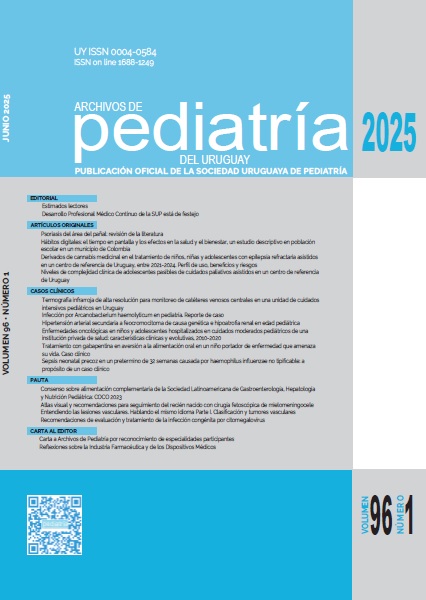Abstract
Early neonatal sepsis is an important cause of neonatal morbidity and mortality. Its incidence is inversely proportional to gestational age.
Haemophilus influenzae is a pleomorphic gram-negative coccobacillus, present in the upper respiratory tract of humans, its mode of transmission is interpersonal, by inhalation of flugge droplets or direct contact with respiratory secretions. In the case of newborns, the infection can be acquired intra-uterus, during childbirth by aspiration of amniotic fluid or by contact through vaginal secretions that contain the microorganism.
The serotype most frequently involved is the non-typeable one, responsible for asymptomatic infections.
We present the clinical case of a 32-week preterm newborn who developed difficult-to-manage refractory septic shock caused by non-typeable Haemophilus influenzae, which led to death in a few hours.
References
Reyes A, Ramírez J. Enfermedad pélvica inflamatoria causada por Haemophilus influenzae: presentación de caso. Perinatol Reprod Hum 2012; 26(3):194-7. Disponible en: https://www.scielo.org.mx/scielo.php?script=sci_arttext&pid=S0187-53372012000300005. (Consulta: 11 enero 2024).
Tesini B. Sepsis neonatal. New York: University of Rochester School of Medicine and Dentistry, 2022.
Roy S, Bharadwaj S, Chandran S. Fatal, fulminant and invasive non-ypeable haemophilus influenzae infection in a preterm infant: a re-emerging cause of neonatal sepsis. Trop Med Infect Dis 2020; 5(1):30. doi: 10.3390/tropicalmed5010030.
Sobrero H, Vezzaro V, Moraes M, Borbonet D. Sepsis neonatal precoz: recomendaciones para su abordaje en la práctica clínica. Arch Pediatr Urug 2022; 93(1):e601. doi: 10.31134/ap.93.1.7.
Mukhopadhyay S, Puopolo K. Clinical and microbiologic characteristics of early-onset sepsis among very low birth weight infants: opportunities for antibiotic stewardship. Pediatr Infect Dis J 2017; 36(5):477-81. doi: 10.1097/INF.0000000000001473.
Puopolo K, Benitz W, Zaoutis T; Committee on fetus and newborn; Committee on infectious diseases. Management of neonates born at =35 0/7 weeks' gestation with suspected or proven early-onset bacterial sepsis. Pediatrics 2018; 142(6):e20182894. doi: 10.1542/peds.2018-2894.
Aleem S, Greenberg R. When to include a lumbar puncture in the evaluation for neonatal sepsis. Neoreviews 2019; 20(3):e124-34. doi: 10.1542/neo.20-3-e124.
Huerta J, Cela de Julián E. Hematología práctica: interpretación del hemograma y de las pruebas de coagulación. En: Asociación Española de Pediatría de Atención Primaria. Congreso de Actualización en Pediatría 2019. Madrid: Lúa Ediciones 3.0, 2019:507-28.
Burchfield D. Re: Management of neonates born at =34 6/7 weeks' gestation with suspected or proven early-onset bacterial sepsis. Pediatrics 2019; 143(5):e20190533A. doi: 10.1542/peds.2019-0533A.
Genes L, Lacarrubba J, Mir R, Céspedes E, Mendieta E. Sepsis neonatal. caracterización en recién nacidos de muy bajo peso: experiencia de once años. Pediatr (Asunción) 2013; 40(2):145-54.
Palavecino E. Recomendaciones del National Committee for Clinical Laboratory Standards para el estudio de susceptibilidad en microorganismos fastidiosos y en microorganismos que presentan mecanismos de resistencia difíciles de detectar. Rev Chil Infectol 2002;19(Supl 2):S129-34.
Higgins R, Saade G, Polin R, Grobman W, Buhimschi I, Watterberg K, et al. Evaluation and management of women and newborns with a maternal diagnosis of chorioamnionitis: summary of a workshop. Obstet Gynecol 2016; 127(3):426-36. doi: 10.1097/AOG.0000000000001246.
Culki C, Andrade A, Pilataxi T, Quimbiulco Z. Sepsis neonatal temprana diagnóstico clínico y de laboratorio. Pol Con (Edición núm. 88) 2023; 8(12):1694-715. doi: 10.23857/pc.v9i1.
Takala A, Pekkanen E, Eskola J. Neonatal haemophilus influenzae infections. Arch Dis Child 1991; 66(4 Spec No):437-40. doi: 10.1136/adc.66.4_spec_no.437.
Martínez A, Edo L. Sepsis neonatal precoz por Haemophilus parainfluenzae: a propósito de un caso. Arch Inv Mat Inf 2022; 13(2):84-6. doi: 10.35366/108723.
Notejane M, Casuriaga A, Giachetto G. Hospitalizaciones por conjuntivitis neonatal infecciosa en un centro de referencia de Uruguay: características clínicas y evolutivas. Rev Hosp Jua Mex 2019; 86(1):26-32.
Dávila C, Hinojosa R, Mendoza E, Gómez W, Espinoza Y, Torres E, et al. Prevención, diagnóstico y tratamiento de la sepsis neonatal: guía de práctica clínica basada en evidencias del Instituto Nacional Materno Perinatal del Perú. An Fac Med 2020; 81(3):354-64. doi: 10.15381/anales.v81i3.19634.
American College of Obstetricians and Gynecologists. Prevention of Group B streptococcal early-onset disease in newborns: ACOG Committee Opinion, Number 782. Obstet Gynecol 2019; 134(1):1. doi: 10.1097/AOG.0000000000003334.
Sola A, Mir R, Lemus L, Fariña D, Ortiz J, Golombek S. Suspected neonatal sepsis: tenth clinical consensus of the Ibero-American Society of Neonatology (SIBEN). Neoreviews 2020; 21(8):e505-34. doi: 10.1542/neo.21-8-e505.
Vera O. Fármacos vasoactivos e inotrópicos en el tratamiento del shock séptico. Cuad Hosp Clín 2016; 57(1):51-8. Disponible en: http://www.scielo.org.bo/scielo.php?script=sci_arttext&pid=S1652-67762016000100008. (Consulta: 11 enero 2024).

This work is licensed under a Creative Commons Attribution 4.0 International License.
Copyright (c) 2025 Archives of Pediatrics of Uruguay


